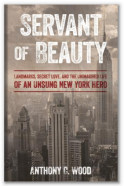
Committee of Neighbors to Get the Clock on Jefferson Market Courthouse Started
Also known as the Village Neighborhood Committee for the Clock on Jefferson Market Courthouse
Formed in 1957, members of this organization advocated for restarting the clock of the Jefferson Market Courthouse as a method of bringing attention to the preservation of the building.
The Committee of Neighbors to Get the Clock on Jefferson Market Courthouse Started was founded to do exactly what its name indicates. The Committee was also founded with the intention of sparking interest in preserving the Jefferson Market Courthouse structure as a whole.
December 1957: The Committee of Neighbors to Get the Clock on Jefferson Market Courthouse Started is formed
October 16, 1960: The Jefferson Market Courthouse Clock starts again
December 22, 1977: The Jefferson Market Courthouse is designated a National Historic Landmark
Margot Gayle, a Greenwich Village resident who lived in close proximity to the Jefferson Market Courthouse, was concerned with the fate of the building. The structure had ceased to be used as a courthouse in the 1940s and had subsequently been slated for demolition multiple times. At a Christmas party in 1957 amidst discussion of how to save the Jefferson Market Courthouse, Gayle, along with other residents, founded The Committee of Neighbors to Get the Clock on Jefferson Market Courthouse Started.1 That night, the new committee sent Mayor Robert F. Wagner, Jr. a telegram "asking that he rehabilitate the clock as a Christmas present to the Village.”2 Over the course of the next few years, the Committee worked to raise the necessary money to start the clock. This work was accomplished through various grassroots campaigns such as the sale of Christmas cards with a local artist's representation of the courthouse.3 On October 16, 1960, the clock was started again, but this was not the end of the committee's work. The neighbors continued their work into the mid-1960s and focused on raising money to keep the clock running.4
The Committee of Neighbors to Get the Clock on Jefferson Market Courthouse Started was the starting point for the campaign to preserve the courthouse building. The clock was seen as "the perfect wedge issue" for the preservation campaign.5 Restoring the clock raised awareness of the building's situation among those in the area. After successfully restoring the clock, residents were more apt to restore the building as well. The same Village residents who fought for the clock led the battle for the conversion of the courthouse into a library in 1961.6
- Friends of Cast Iron Papers
National Trust for Historic Preservation Library Collection
University of Maryland
College Park, MD 20742 - Margot Gayle Photo Collection
New York Preservation Archive Project
174 East 80th Street
New York, NY 10075
Tel: (212) 988-8379
Email: info@nypap.org - Oral History with Margot Gayle
Greenwich Village Society for Historic Preservation
232 East 11th Street
New York, NY 10003
Tel: (212) 475-9585
Email: info@gvshp.org
Charles Hosmer, Interview with Margot Gayle, under the auspices of the Eastern National Park and Monument Association, 23 June 1982. University of Maryland Libraries Collection.
Oral History with with Margot Gayle (available upon request) - New York Preservation Archive Project
174 East 80th Street
New York, NY 10075
Tel: (212) 988-8379
Email: info@nypap.org
- Charles B. Hosmer, Interview with Margot Gayle, under the Auspices of the Eastern National Park and Monument Association, 23 June 1982.
- Anthony C. Wood, Preserving New York: Winning the Right to Protect a City’s Landmarks (New York: Routledge, 2008), page 261.
- Laura Hansen, Interview with Margot Gayle, 23 July 1996, Greenwich Village Society Preservation Archive and Oral History Project at the Greenwich Village Society for Historic Preservation.
- ”‘Villagers’ Rally for a Live Clock,” The New York Times, 6 October 1963.
- Anthony C. Wood, Preserving New York: Winning the Right to Protect a City’s Landmarks (New York: Routledge, 2008), page 261.
- ”‘Villagers’ Fight to Save Building,” The New York Times, 19 February 1961.


